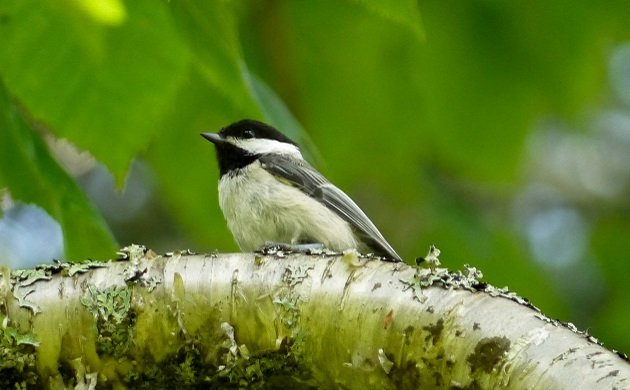Pelagic birding off the Atlantic coast of Florida can be a frustrating experience, usually involving long waits of up to an hour or more interspersed with brief flurries of activity — a far cry from pelagic birding off of coasts blessed with cold water currents and nutrient rich upwelling such as California, southeast Australia, and Peru. In the pelagic ‘deserts’ of Florida, as in deserts on land, specialist bird species manage to carve out an existence. Instead of tubenoses such as shearwaters and storm-petrels, the most numerous and commonly encountered birds in the pelagic waters of southern Florida are terns. This article will focus on the Sooty Tern and Bridled Tern.
Sooty Tern, by Trey Mitchell
The globally widespread Sooty Tern (Onychoprion fuscatus) is by far the most numerous of the two in Florida waters, here represented by the nominate subspecies fuscatus. It can be differentiated from its close cousin the Bridled Tern by the dark nape in adults, black back and upper surface of the wings, and mostly black tail with very narrow white edges on the outer tail feathers. This species also has a noticeably stronger and direct flight pattern, which can be very helpful when identifying individuals from a distance on a boat.
Sooty Terns are familiar to those who dedicate large amounts of time at sea such as seafarers and fishermen, who often zero in on dense gatherings of fish by searching out untidy flocks of these terns clustering over a patch of ocean. These birds find feeding opportunities when ocean-going predators force smaller bait fish up towards the surface. Unlike most other terns, Sooty Terns feed by dipping or plucking fish right off the water’s surface. Unlike the Bridled Tern, these birds rarely alight on flotsam or rest on the water perhaps due to the little waterproofing in their plumage – a secondary trait that helps distinguish the two species out in the field.
Birders visiting the state will often opt to take a ferry out to Dry Tortugas National Park for a day trip or to stay there overnight, instead of taking a pelagic trip off the coast of Florida (where they are common). An estimated 20,000 pairs nest on Bush Key in the park from February to late July, and one is usually welcomed to this tiny cluster of islands by the sudden appearance of large numbers of Sooty Terns incessantly calling “Wide Awake!” It is one of the avian spectacles of the continental United States, and a trip to these islands is not soon forgotten.
Bridled Tern, by Trey Mitchell. Note the pale nape and back.
Despite the similar appearance, the equally widespread Bridled Tern (Onychoprion anaethetus), represented by the subspecies melanoptera in the West Indies and Florida, is a very different bird with very different habits. It can be differentiated from Sooty Tern by the grayish back and upper surface of the wings, the pale nape in the adults, and the extensive white edges on the outer tail feathers. The flight pattern is more graceful and erratic, and the bird is altogether of a lighter and more delicate build.
Bridled Terns also have the habit of regularly perching on flotsam and jetsam unlike the previous species, exploiting a completely different marine niche. A much more solitary bird, this tern lives in close association with algal mats such as Sargassum that accumulate on current edges. Following these edges on a pelagic birding trip is a good strategy for finding individuals of this species in Florida waters. On land, nesting occurs inside sheltered crevices on small offshore cays and islands. Colonies tend to be considerably smaller compared to the previous species. Within the continental United States, nesting was first documented in 1987 in the Florida Keys, and since 2005 nesting has occurred in small numbers on Bush Key in the Dry Tortugas.
Bridled Tern, by Trey Mitchell — perched on flotsam!
Despite their superficial similarity, Sooty Tern and Bridled Tern are two very different species with very different strategies on how to survive in the nutrient poor waters of the tropical Atlantic. A visit to a breeding colony of Sooty Terns is a must on any birder’s itinerary, while the Bridled Tern can be appreciated for being a specialist that exploits a microhabitat that few other bird species do as successfully.







 New writers welcome – please contact us for details.
New writers welcome – please contact us for details.

















Thanks for the informative article. I was fortunate to see 2 Bridled Terns in NJ last summer during Hurricane Irene. Great experience watching those birds master the wind while us humans were being sandblasted!